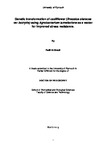Genetic Transformation of Cauliflower (Brassica oleracea var.botrytis) using Agrobacterium Tumefaciens as a Vector for Improved Stress Resistance
| dc.contributor.supervisor | Fuller, Mick | |
| dc.contributor.author | Al-Swedi, Fadil | |
| dc.contributor.other | Faculty of Science and Engineering | en_US |
| dc.date.accessioned | 2013-06-17T08:49:29Z | |
| dc.date.available | 2013-06-17T08:49:29Z | |
| dc.date.issued | 2013 | |
| dc.date.issued | 2013 | |
| dc.identifier | 10162484 | en_US |
| dc.identifier.uri | http://hdl.handle.net/10026.1/1531 | |
| dc.description.abstract |
Genetic transformation of cauliflower (Brassica oleracea var.botrytis) using Agrobacterium tumefaciens as a vector for improved stress resistance. Fadil Al-Swedi Cauliflower (Brassica oleracea var. botrytis) is described as a recalcitrant plant to genetic transformation processes especially Agrobacterium-mediated and as an extremely low frequency event then it requires a large amount of explants for this procedure to succeed. This thesis describes the development and refinement of a mass propagation system for cauliflower micropropagation and its use for overcoming recalcitrance to genetic transformation. Shoot meristematic tissue was taken from the curd of cauliflower and used to establish in-vitro cultures in liquid medium. Explants were cultured in a Murashige and Skoog (MS) medium containing various plant growth regulators combinations to induce shoot regeneration and which were optimised to be 2 mg L-1 (9.29 μM) kinetin and 1 mg L-1(4.9 μM) IBA. Shoots were cultured for 4–6 weeks to obtain rooted plants, which were then suitable for weaning and subsequently produce fully- developed in-vivo plants in pots in soil with a 95%+ success rate. A procedure for detection of the presence of insert DNA in recombinant plasmids in individual Agrobacterium tumefaciens strains was refined. Cauliflower was transformed using the EHA105 strain of A. tumefaciens harboring the binary vector pPRTL2 plasmid carrying the antioxidant gene Ascorbate peroxidase (APX) for increased stress resistance coupled with neomycin phosphotransferase II (nptII) for resistance to kanamycin and β-glucuronidase (GUS) as a marker gene. Selection was carried out in MS medium containing kanamycin (50 mg L-1), and surviving tissues were then tested by histochemical GUS assay.Agrobacterium-mediated plant genetic transformation requires a two-step process for its success: selection and regeneration of transformed tissues, and the elimination of the transformation vector (Agrobacterium). This study used carbenicillin and cefotaxime in MS media to eliminate A. tumefaciens, at selection levels of 25 and 50 mg L-1 kanamycin. Kanamycin severely reduced explant growth and regeneration of control cultures at concentrations as low as 10 mg L-1 and completely inhibited shoot organogenesis at 50 mg L-1. The integration of APX gene into putative transformant lines was confirmed using GUS and leaf disc assays. Genomic integration of the gene cassette was optimised using PCR analysis with primers flanking npt II and CaMV promoter regions. The stable integration of the APX gene in the putative transgenic plants was detected using PCR at 478bp. The result confirmed the first report of transformation with APX gene in Brassica oleracea. Thus, a protocol for effective Agrobacterium-mediated genetic transformation of cauliflower was optimized. Transformed and control lines were sub-cultured many times on maintenance medium over 2 years without any loss of the transgene and then tested for salt resistance as in-vitro and in-vivo plants using a leaf disc assay. Control plants had little or no NaCI resistance whilst transformed plants showed varying degrees of resistance. Analysis of APX gene expression under salt treatment showed that putative transgenic cauliflower survived salinity stress compared with control plants. Non-acclimated and acclimated in-vivo plants were also assessed for resistance to frost. Both non-acclimated and acclimated APX transformed lines showed improved frost resistance compared to controls. The results clearly confirmed that NaCI and frost resistance were stable traits attributable to improved APX expression. | en_US |
| dc.description.sponsorship | Iraqi Ministry Of Higher Education and Scientific Research(MOHESR) | en_US |
| dc.language.iso | en | en_US |
| dc.publisher | University of Plymouth | en_US |
| dc.subject | Micropropagation | |
| dc.subject | Agrobacterium tumefaciens | |
| dc.subject | Cauliflower | en_US |
| dc.title | Genetic Transformation of Cauliflower (Brassica oleracea var.botrytis) using Agrobacterium Tumefaciens as a Vector for Improved Stress Resistance | en_US |
| dc.type | Thesis | |
| plymouth.version | Full version | en_US |
| dc.identifier.doi | http://dx.doi.org/10.24382/4244 |
Files in this item
This item appears in the following Collection(s)
-
01 Research Theses Main Collection
Research Theses Main


